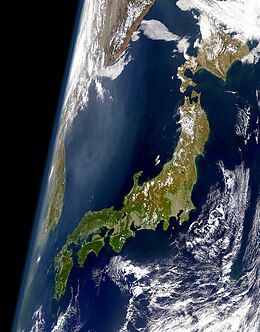ජපානයේ භූගෝලීය ලක්ෂණ
ජපානය යනු නැගෙනහිර ආසියාවේ, පැසිෆික් වෙරළ තීරයේ දූපත් සමූහයකින් සමන්විත රටකි.[8] එය දූපත් 6,852 කින් සමන්විත වේ.[9] ප්රධාන දූපත් පහ (5) වන්නේ හොකයිඩෝ, හොන්ෂු, කියුෂු, ෂිකෝකු සහ ඔකිනාවා ය. Remote islands 6,847ක් ඇත.[10] Ryukyu දූපත් සහ Nanpō දූපත් ප්රධාන දූපත් වලට දකුණින් සහ නැගෙනහිරින් පිහිටා ඇත.
 | |
| Continent | Asia |
|---|---|
| Region | East Asia |
| Coordinates | 36°N 138°E / 36°N 138°E |
| Area | Ranked 61st[1] |
| • Total | 377,975.26[2] km2 (145,937.06 sq mi) |
| • Land | 87.93099% |
| • Water | 12.06901% |
| Coastline | 29,751 km (18,486 mi) |
| Borders | None |
| Highest point | Mount Fuji 3,776 m (12,388 ft)[3] |
| Lowest point | Hachirōgata −4 m (−13 ft)[3] |
| Longest river | Shinano River 367 km (228 mi)[4] |
| Largest lake | Lake Biwa 671 km2 (259 sq mi)[5] |
| Climate | Varied; tropical in the south to cool continental in the north, and mountainous areas being Subarctic, or Alpine Tundra[3] |
| Terrain | Mostly rugged, volcanic and mountainous[3] |
| Natural resources | Marine life and mineral resources in the territorial waters.[6][7] Small deposits of coal, oil, iron and minerals on land.[3] |
| Natural hazards | Volcanic eruptions, tsunami, earthquakes and typhoons[3] |
| Environmental issues | Air pollution; acidification of lakes and reservoirs; overfishing; deforestation[3] |
| Exclusive economic zone | 4,470,000 km2 (1,730,000 sq mi) |
ආශ්රිත
සංස්කරණයමූලාශ්ර
සංස්කරණය- ^ https://www.indexmundi.com/facts/indicators/AG.SRF.TOTL.K2/rankings.
{{cite web}}: Missing or empty|title=(help) - ^ "【お知らせ】令和3年全国都道府県市区町村別面積調(7月1日時点), Reiwa 3rd year National area of each prefecture municipality (as of July 1)" (ජපන් බසින්). Geospatial Information Authority of Japan. 29 September 2021. January 1, 2021 දින මුල් පිටපත වෙතින් සංරක්ෂණය කරන ලදී. සම්ප්රවේශය October 15, 2021.
- ^ a b c d e f g "Japan". CIA World Factbook. සම්ප්රවේශය 11 November 2017.
- ^ "Shinano River". Encyclopædia Britannica. සම්ප්රවේශය 11 November 2017.
- ^ "Lake Biwa". Encyclopædia Britannica. සම්ප්රවේශය 11 November 2017.
- ^ "What is the Volume of Japan's 200-nm Exclusive Economic Zone?". The Ocean Policy Research Institute. September 20, 2005. July 29, 2019 දින මුල් පිටපත (website) වෙතින් සංරක්ෂණය කරන ලදී. සම්ප්රවේශය 30 July 2019.
- ^ "World review of fisheries and aquaculture". Food and Agriculture Organization. සම්ප්රවේශය January 18, 2014.
- ^ "Water Supply in Japan". Ministry of Health, Labour and Welfare. January 26, 2018 දින මුල් පිටපත (website) වෙතින් සංරක්ෂණය කරන ලදී. සම්ප්රවේශය 26 September 2018.
- ^ "離島とは(島の基礎知識)" (ජපන් බසින්). Ministry of Land, Infrastructure, Transport and Tourism. November 13, 2007 දින මුල් පිටපත (website) වෙතින් සංරක්ෂණය කරන ලදී. සම්ප්රවේශය 3 October 2018.
- ^ "離島とは(島の基礎知識) (what is a remote island?)". MLIT (Ministry of Land, Infrastructure, Transport and Tourism) (ජපන් බසින්). Ministry of Land, Infrastructure, Transport and Tourism. 22 August 2015. 2007-11-13 දින මුල් පිටපත (website) වෙතින් සංරක්ෂණය කරන ලදී. සම්ප්රවේශය 9 August 2019.
MILT classification 6,852 islands (main islands: 5 islands, remote islands: 6,847 islands)
- All Geography of Japan information taken from the Japan. The World Factbook. Central Intelligence Agency..
භාහිර සබැඳි
සංස්කරණයජපානයේ භූගෝලීය ලක්ෂණ හා සබැඳි මාධ්ය විකිමාධ්ය කොමන්ස් හි ඇත.